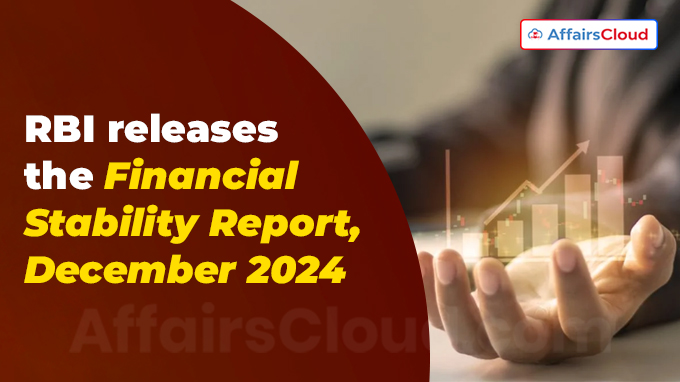 In December 2024, the Reserve Bank of India (RBI) released the half-yearly publication of the ‘Financial Stability Report (FSR), December 2024’ which shows the joint assessment of the sub-committee of the Financial Stability and Development Council (FSDC) of the potential risks to financial stability and the resilience of the Indian financial system.
In December 2024, the Reserve Bank of India (RBI) released the half-yearly publication of the ‘Financial Stability Report (FSR), December 2024’ which shows the joint assessment of the sub-committee of the Financial Stability and Development Council (FSDC) of the potential risks to financial stability and the resilience of the Indian financial system.
- The report covered both international and domestic economic conditions, the performance of Scheduled Commercial Banks (SCBs) and Non-Banking Financial Companies (NBFCs), and the solvency of the insurance sector.
- The report observed that SCBs has been strengthened by strong profitability, decreasing Non-Performing Assets (NPAs) and sufficient capital and liquidity buffers.
About Financial Stability Report (FSR):
i.The FSR is a biannual report released by the RBI in June and December.
- The report is prepared by the Financial Stability Unit (FSU) and is a joint evaluation by the Sub-Committee of the Financial Stability and Development Council (FSDC).
- The RBI published its first FSR in 2010.
ii.The report taking inputs from financial sector regulators i.e. RBI, Securities and Exchange Board of India (SEBI), Insurance Regulatory and Development Authority of India (IRDAI), Pension Fund Regulatory and Development Authority (PFRDA) and Ministry of Finance(MoF).
iii.The report assesses the financial system’s resilience and the risks to financial stability.
Key Findings:
i.As per the RBI’s FSR, the Indian economy is demonstrating strength and resilience thus it has projected that India’s Gross Domestic Product (GDP) growth rate will be at 6.6% in the Financial Year 2024-25(FY25).
- The report has outlined this growth will be mainly driven by a resurgence in rural consumption, an increase in government spending and investment, robust services exports, declining Non-Performing Assets (NPAs) and adequate capital and liquidity buffers.
ii.The report highlighted that India’s GDP moderated to 6% during the 1st half (H1:April to September) of FY25 from the 8.2% and 8.1% growth registered during H1 and H2 of FY24, respectively. The report noted that despite this latest deceleration, India’s structural growth drivers’ remains intact.
- Central government’s debt-to-GDP ratio is expected to decrease to 56.8% by 2024-25 from 62.7% (2020-21). States’ outstanding liabilities are projected to decline from 31% to 28.8% during the same period.
iii.The report highlighted that unhedged External Commercial Borrowings (ECBs) reached at USD 65.49 billion, nearly 34.4% of the total debt increased under this avenue.
- It further mentioned that increase in foreign currency borrowings by NBFCs could potentially pose currency risks to the extent they are unhedged.
iv.The report highlighted that new accretion of NPAs in the retail loan portfolios was led by slippages in the unsecured loan book, at 51.9% as of September 30, 2024.
v.As per the report, Liquidity Coverage Ratio(LCR) of the banking system declined from 135.7% (in September 2023) to 128.5% (in September 2024). This decrease is mainly attributed by an increase in net cash outflows, which is further influenced by an increase in less stable sources of funding.
vi.The report underscored that the overall performance of listed Private Non-Financial Companies (NFCs) has remained stable in 2024 as sales growth Year-on-Year (Y-o-Y) remained at 6.2% in H1 of FY25 as in H2 of FY24.
vii.Monetary penalties imposed by the RBI on regulated entities from June to November 2024 have decreased by 47% to Rs 30 crore as against Rs 57 crore in the same period a year ago.
- Of the total 153 monetary penalties, the central bank has imposed fines on 5 Public Sector Banks(PSBs) and five private sector banks. It has penalised 3 foreign banks, 2 Regional Rural Banks(RRBs), 116 Cooperative Banks(CBs), 14 Non-Banking Financial Companies (NBFCs), and eight housing financiers.
- NBFCs have healthier balance sheets.
viii.As of December 23, 2024, the liquidity deficit stood at 2.43 trillion rupees, driven by tax outflows and the central bank’s foreign exchange interventions.
India’s GNPA Ratio Declined to 12-year Low to 2.6% in September 2024
i.As per the RBI’s FSR, the asset quality of SCBs improved further with their Gross Non-Performing Assets(GNPA) ratio declined to 12-year low of 2.6% in September 2024.
- The stress test scenario has further projected that GNPA ratio could possibly increase to 3% by the end of March 2026, for 46 banks under the baseline scenario, and 5% and 5.35%, respectively, under two different high risk scenarios.
- While, the Net NPA (NNPA) ratio of the SCBs continue to be at around 0.6%.
ii.Similarly, the report has projected that the Capital Adequacy Ratio (CAR) could decrease to 16.5% in March 2026 in the baseline scenario and decrease to 15.7% and 14.3% in two different high risk scenarios.CAR stood at 16.6% in September 2024.
iv.The Provisioning Coverage Ratio (PCR) of SCBs increased further to 77% in September 2024, mainly due to the proactive provisioning by PSBs.
Three Banks Continue to Display Risky Metrics:
i.The report showed that at the starting of the 2014, three-fourths(75%) out of 33 public and private sector banks examined under the ‘Key Risk Indicators (KRIs)’ framework were found deficient in 3 or more KRIs.
ii.The report noted that only 3 banks accounting 15% of total banking system assets have been found to be deficient in 3 KRIs in September 2024, despite sector-wide improvements.
iii.As per the report, loan sector registered the growth of 13.4% 3-Month Moving Average(3-MMA), in September 2024, investments reported lower growth of 7.6% 3-MMA, this resulted into the combined assets (loan +investments) growth of 11.2% (3-MMA), same as deposit growth of 11.2% (3-MMA).
iv.The report noted that increase in bank profits as well as increase in equity capital has been a significant additional source of funds, which contributed to an increase in loan-deposit ratio.
- Also, it observed that bank reliance on borrowings for bridging the financing gap increased as loan growth outpaced deposit growth leading to an increase in loan-deposit ratio.
About KRI Framework:
i.This framework was formulated by the International Monetary Fund (IMF), which measures vulnerability of banks by merging the Capital adequacy, Asset quality, Management, Earnings, Liquidity, and Systems(CAMELS) supervisory framework with market-based metrics and flags institutions based on specified thresholds that differ by jurisdictions.
ii.The framework evaluates the bank’s overall risk based on 5 key indicators: capital adequacy, asset quality, profits, liquidity and market metrics.
Points to Note:
i.GNPA is the amount of the debts an establishment or people owe to the organization that has failed to collect their contractual obligations.
ii.NNPA is the remaining amount after the bank has deducted the provision for doubtful and unpaid debts from the total GNPA.
iii.CAR, also known as Capital to Risk Assets Ratio (CRAR), is the ratio of a bank’s capital in relation to its risk weighted assets and current liabilities.
iv.PCR is the percentage of funds that a bank sets aside for covering losses due to bad debts.
About Financial Stability and Development Council (FSDC):
i.The FSDC is a non-statutory apex council under the Ministry of Finance(MoF).The Council is chaired by the Union Finance Minister.
ii.The Raghuram Rajan Committee (2008) on financial sector reforms had first proposed setting up of FSDC.
About Reserve Bank of India(RBI):
Governor- Sanjay Malhotra (26th Governor of RBI)
Headquarter- Mumbai, Maharashtra
Established-1 April, 1935




